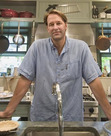Michael Ruhlman's Blog, page 39
July 12, 2013
Friday Cocktail Hour: La Palmona Revisited
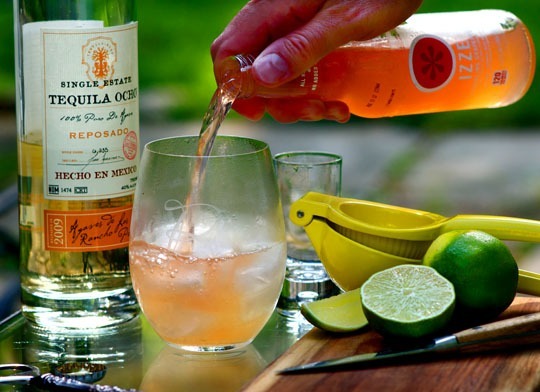
The refreshing Paloma: tequila, lime, grapefruit soda. Photo by Donna Turner Ruhlman.
This has become my favorite of Donna’s cocktail shots because it so accurately reflects the experience of drinking it. And as she’s on the road, playing hookey from her camera, I’m reposting this perfect summer cocktail. It’s dry and hot here in Clevelandtown, and these are seriously refreshing. Tequila, lime juice, and grapefruit soda. Couldn’t be simpler.
I love Tequila Ocho Reposado. Normally I save the good stuff for straight-up drinking, but it’s worth using in the Paloma because the lime and grapefruit flavors intermingle with and elevate, rather than obscure, the flavor of the tequila. And I make it strong, so I can taste it, goddammit.
Izze is excellent soda (not too sweet, lots of carbonation) and it’s what my grocery store carries. Jarritos is the brand most often recommended. But half grapefruit juice and half soda water works as well.
Have a most excellent weekend all!
Paloma
3 ounces tequila
juice of 1/2 lime
3 ounces grapefruit soda, or to taste
1 wedge of lime for garnish, if you wish
Combine all the ingredients in a beautiful glass filled with ice.
Swirl to combine.
If it’s very hot where you are, pause to consider you are about to indulge yourself with one of the most refreshing cocktails you’ve ever had.
If you liked this post on the Paloma, check out these other links:
My past cocktail posts on making margaritas, El Diablo, and sipping tequila,
Be a member of the Tequila Interchange Project.
Rick Bayless’s Frontera Grill in Chicago has some pretty stellar margaritas; here are some of his cocktail recipes.
© 2013 Michael Ruhlman. Photo © 2013 Donna Turner Ruhlman. All rights reserved.
July 8, 2013
Wheat Berry Salad
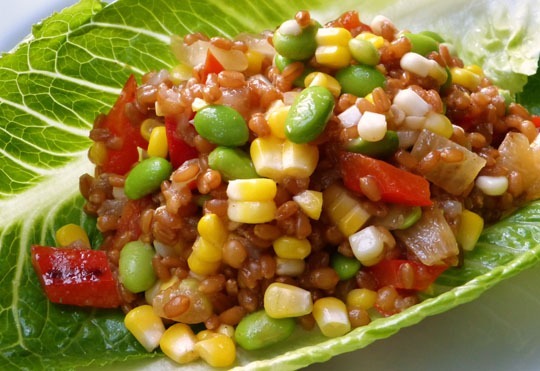
Wheat berry salad. Photo by Donna Turner Ruhlman.
I’ve decided to go vegan.
Yep. Vegan all the way. Not for ethical reasons, but for reasons of vanity. I’m getting fat. I’m getting old and the fat tends to stick around. And where diets are concerned, I know one thing for sure: it’s very hard to gain weight on a vegan diet. So vegan it is, at least until I drop twenty.
For my first night as a vegan, I went for a wheat berry salad, because it satisfies like meat. I first tried wheat berries after looking through Heidi Swanson‘s book, Super Natural Cooking. You have to work your jaws. The whole wheat kernel has lots of fiber and nutrition. And it can carry all kinds of different flavors, so there’s no end to what kind of dishes you can create with wheat berries. Also, the weather was very hot and this is delicious at room temperature. This wheat berry salad proved to be the perfect summer entree.
I made this recipe the first week of July, a Monday. I’d promised friends I’d grill Vienna beef hot dogs with natural casings, as always, on the Fourth (something of a moral obligation in this household). The day after the wheat berry salad I really wanted an egg on a pasta dish I was making.
At least I could say I did it, though. I went almost 24 hours as a vegan. It was easy. I think I’m going to be a vegan all the time now. I’m just never going to be skinny.
Wheat Berry Salad
For the salad
1 cup wheat berries
3 1/2 cups water
1 Spanish onion, diced
1 bay leaf
Salt to taste
Olive oil
1 red bell pepper, cut into small dice
2 ears corn (or 1 cup corn kernels)
1 cup shelled edamame (or lima bean or peas), cooked
Freshly ground black pepper
For the vinaigrette
Juice of 1/2 lemon
1 tablespoon minced shallot
1 garlic clove, minced
Salt
1/8 teaspoon cayenne
1/4 to 1/3 cup olive oil
Freshly ground black pepper
4 leaves romaine lettuce or head lettuce (optional)
In medium saucepan over high heat, combine the wheat berries and water, and add half the diced onion and the bay leaf. When the water reaches a simmer, cover and reduce the heat to low. After 30 minutes, add 1/2 teaspoon salt, stir to dissolve, and taste the cooking water. If it needs more seasoning, add another 1/2 teaspoon salt. Cover and continue cooking until tender, another 30 minutes or so. Uncover and simmer until almost all of the water has cooked off. Set this aside and keep at room temperature or chill.
In a sauté pan over medium heat, heat a film of olive oil, then saute the remaining diced onion. When the onion is tender, add the red pepper and sauté until the pepper is tender. Remove from the heat. While the onions and peppers are cooking, boil the corn ears for a few minutes. Hold them under cold water till they’re comfortable to handle, then slice the kernels off the cob into a large salad bowl. Add the cooked edamame, the onions and peppers, and the wheat berries.
To make the dressing, combine the lemon juice, shallot, garlic, and a three-finger pinch of salt and allow to sit for 5 to 10 minutes. Add the cayenne, and whisk in the oil. Taste. If it’s too sharp, add more oil.
Toss the vegetables and wheat berries with the dressing, holding some back. Add freshly ground black pepper to taste. Taste and evaluate. Add more dressing or additional lemon juice to taste.
Serve in lettuce leaves if you wish.
Serves 4
If you liked this post, take a look at these links:
My past posts on raw zucchini salad and preparing beef heart.
Learn about the health benefits of wheat berries.
Here are 5 other uses for wheat berries.
Eating Well shares a few wheat berry recipes.
© 2013 Michael Ruhlman. Photo © 2013 Donna Turner Ruhlman. All rights reserved.
July 5, 2013
Friday Cocktail Hour: Limoncello Cocktail

The Seersucker 751/Cocktail and photo by Donna Turner Ruhlman
Donna asked to shoot a cocktail. I said, “Go ahead.” She said, “I want to do a Sidecar.” I said, “It’s summertime and hot, how about something refreshing?”
She remembered a bottle of limoncello that she’d bought in a moment of nostalgia, recalling a time when she’d enjoyed drinking it with my mom. “I want to shoot ice-cold shots of it,” she said. But then she tasted it straight. She found it cloyingly sweet and knew she’d never drink it like this (and wondered how she could have such fond memories of it). She did a little research and found a limoncello cocktail using gin. She tried it. The gin clashed with the limoncello. She found one calling for grilled thyme. I told her I didn’t like thyme in beverages, grilled or otherwise (grilled?!).
She moved to the more neutral vodka, which worked better. But it needed a little oomph, as limoncello is basically lemony, 40-proof simple syrup. Grand Marnier, I thought, would give it some complexity and maintain the citrus motif. Correct! And with the two sweet liqueurs, a bold squeeze of fresh lemon juice for brightness and balance. Topping it off with fizzy water, we had a truly refreshing cocktail for the summertime heat. If it’s daylight and hot, add more soda water and you won’t get bombed before dark.
The Seersucker 751
0.5 ounce/15 grams Grand Marnier (or other orange liqueur)
1 ounce/30 grams limoncello
1.5 ounces/45 grams vodka
2 to 4 ounces/60 to 120 grams soda water (or to taste)
1 solid squeeze of lemon
Combine the Grand Marnier, limoncello, and vodka in a highball glass.
Fill the glass with ice and add soda water to taste.
Squeeze a wedge or disc of lemon into the drink.
If you liked this post, take a look at these links:
My past cocktail posts with vodka: the Madras, Sea Breeze, Cosmo, Lemon Drop, and Moscow Mule.
Make your own limoncello at home.
Case Study: Presto Chango, Limoncello!
Here are a few more cocktail recipes that use limoncello.
© 2013 Michael Ruhlman. Photo © 2013 Donna Turner Ruhlman. All rights reserved.
July 2, 2013
“I Like New York in June”
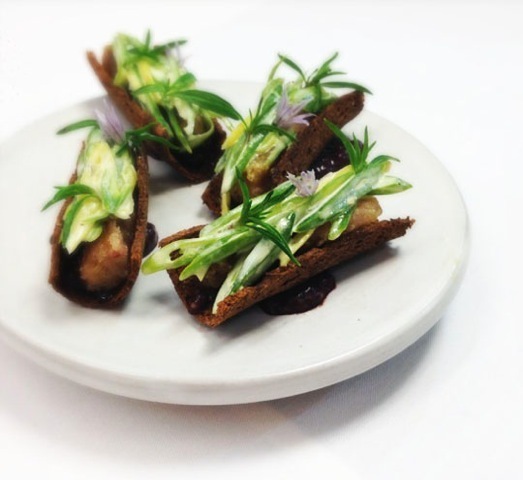
Betony’s bone marrow: summer beans, savory, pumpernickel bread, and purple mustard. Photo by the chef, Bryce Shuman.
Donna and I arrived in New York last Tuesday to begin setting up our city outpost in the West Village, and we were struck anew by the extraordinary dining scene there. I plotted three very different theatrical performances, and they parallel the dynamism and diversity of the traditional, quirky, experimental food of NYC. I wonder if these traits cause coincidences. Last year I had a surprise encounter with my news mentor, Arthur Gelb, returning me to the Times, formative if unhappy years. This year we arrived in Times Square to have a pre-show cocktail at Sardi’s. We hadn’t been there a few minutes, and I don’t know what we’d said other than placing an order for a wine and a martini, but we’d struck up a conversation with a woman seated catty-corner to us. She said, “You have a good marriage. I can tell.”
I asked. “How do you know?”
“I just know.” She added, “I’m a marriage counselor.”
She asked us what we were seeing and I told her Lucky Guy. This is the Nora Ephron play starring Tom Hanks, all about the newspapering world of the 1970s, ’80s, and ’90s, which I’d been an underling part of from 1985 to 1987. We stood to leave, and there at a table behind the marriage counselor was Jeanne Pinder, a long-time Times editor who was not only tough and smart (everyone there was), but was also one of the few people in the newsroom to compliment this miserable copyboy. She was having a drink with a long-time Times reporter and paragon of reporting. But again, as one year ago, to happen on my past just before entering a show about those days, seemed an omen. Jeanne told us that she left the Times to be CEO and founder of the site ClearHealthCosts.com, which aims to inform people such as myself what the colonoscopy that’s in my future should cost. But she misses the Times, and as she had a hand, on both foreign and city desks, in too many Pulitzer Prizes to list here, I know the paper is the lesser for her being gone. I felt lucky for the reunion.
DB Bistro was perfect after the show—cold corn soup, salad, ravioli. A place we were forced to return to the following day for lunch with my friend and a Conde Nast Traveler editor Peter Stevenson, who midwifed my cover story on Gascony for its annual food issue. Donna and I splurged on the lobster salad, each. What I love about Boulud’s places is not so much the food (dependably excellent) as the service, which combines ease with refinement without calling attention to itself.
Wednesday had started hopefully, with a recording of a podcast about my upcoming book, The Book of Schmaltz, with David Leite, founder of Leite’s Culinaria, and its exec editor, Renee Schettler. And it would conclude wandering the long tree-lined West 4th Street to Fedora, where I very much wanted to eat after Megnut recommended it so highly. Though it was Wednesday night, the whole street throbbed with people as if it were Friday. It seemed there wasn’t an empty seat in the whole village. Or at least on West 4th, where there seems to be a restaurant every five feet.
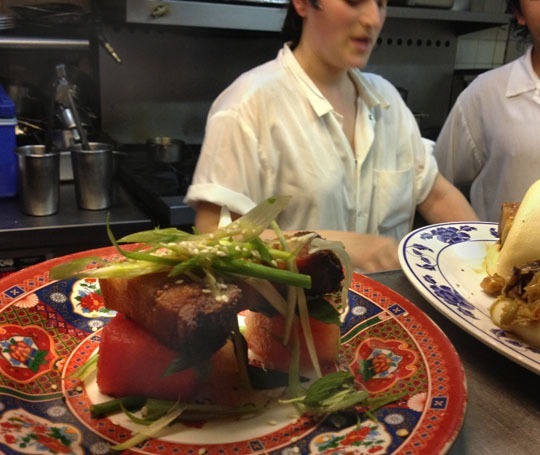
Pork belly and watermelon and steamed buns arrive at the pass at the Fatty Crab.
We headed back north and found two empty seats at the bar at the The Fatty Crab, where the bartender Julian was so friendly, he insisted we have the pork belly and watermelon and ordered it for us. Everything was fabulous, all the food hammered out by two young cooks working a closet-sized line—love seeing that. Then for a long walk along a stunning stretch of the Hudson River Greenway, once a collection of rotting piers, now a thriving public space.
Thursday our friend Annie got us a booth at the cabaret venue 54 Below beneath the old Studio 54 to see Sherie Rene Scott, who did a fabulous, languorous, voluptuous rendition of David Byrne’s “Life During Wartime” and concluded with a medley of “I Am an Animal,” fitting as she’d begun the comedic cabaret announcing that she had started eating meat again.
Annie asked me to find a place nearby for dinner. I hate this. My mom always asks me this, too—Where should I eat? As if I spend all my time in the West 50s exploring the restaurants. Thanks to the new media I can ask Twitter and, as if by magic, get a half dozen excellent suggestions in a half hour (thank you, all!). But this request found an uncommon response. One follower I don’t know suggested BetonyNYC. Because the @ was used, one of the partners in that restaurant, @EamonRockey, who has moved to the front of the house, spotted it and invited me on Twitter to the month-old restaurant on West 57th. He copied executive chef @BryceShuman, who reiterated the invite. Well, what was I supposed to do? What’s the etiquette here? Would it have been rude not to accept? We went with the flow and were glad we did: an elaborate, outstanding bone marrow preparation (above), deep-fried pickled peppers, poached lobster that were, remarkably, dispatched à la minute and cooked at sous vide temperatures, keeping them very tender, and my favorite, grilled short ribs (grilling being my favorite way to finish them; Shuman sous vides them first for 48 hours). The two veterans of 11 Madison Park are off to an auspicious start.
A friend had finagled tickets the next evening to David Byrne’s interactive (and unlikely) musical about Imelda Marcos, Here Lies Love, that somehow blends torch songs and disco, martial law, assassination, the corrupting forces of political power, stirring optimistic love songs, and fabulous dancing while stage technicians continually rearrange the central stage, moving the standing audience along with it, bringing the audience into the play itself as potential voters and man-on-the-street photo ops. The title song is so catchy I bought it but won’t play it unless I want to be hearing it in my head all day. David Byrne was one of my first stories for the Times. I was 22 and flew myself down to Texas where he was filming his musical True Stories. It felt like a full circle. Just like seeing Jeanne Pinder. Byrne, the protean artist, had come full circle and it was a thrill to see his amazing brain still creating.
After the show we walked across the street to Indochine. We hadn’t eaten all day and it was, well, across the street, but more important, nearly thirty years ago, I’d taken my father to Indochine when I was a lowly, miserable, ambitious copyboy. Thai beef salad, a duck confit Thai salad, crispy shrimp, Thai scallops—still delicious. Manhattan in June—this time it was sweet.
If you liked this post, take a look at these links:
This year’s opening number at the Tony Awards is one of the best in history (Mike Tyson!) and worth the preceding commercial.
One of Donna’s fave places to stay in NYC is the Ace Hotel, which is also home to April Bloomfield’s The Breslin and the Jon Dory.
© 2013 Michael Ruhlman. Photo © 2013 Donna Turner Ruhlman. All rights reserved.
June 28, 2013
Friday Cocktail Hour: The Madras
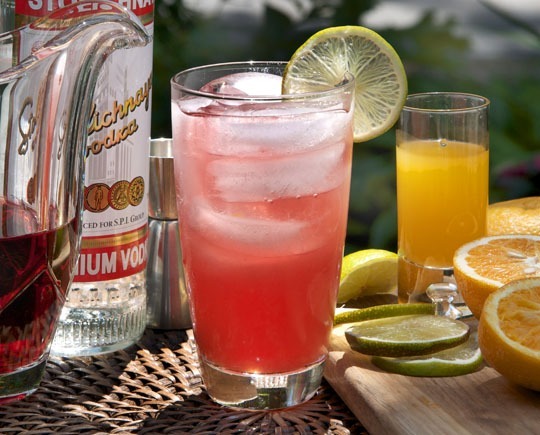
Swap OJ for grapefruit juice and a Sea Breeze becomes a Madras.
Photo by Donna Turner Ruhlman.
When I returned to the CIA in the fall of 1999, two years after the publication of Making of a Chef wherein I described the humiliating service experience on my first day at St. Andrew’s restaurant, and Chef Czack lofted an overly generous tip onto my table with a look of withering disdain for my shoddy performance, he himself hosted me at the Danny Kaye Theater for an interview. I had been provided a pink beverage, strangely, as one almost always is given water. Chef Czack held out his hand to the drink. “Can you tell us what this is?” he asked me. I looked blankly at it, took a sip, looked out at the audience as a deer into headlights. I had not been expecting a sucker punch and confessed ignorance.
“A Sea Breeze,” said Chef Czack, allowing me to relive the humiliation. Or so I recall.
All in good fun, and at least I didn’t say Madras.
Here, in the last of a series of pink drinks, is an actual Madras, an eminently refreshing elixir that also describes how the altering of a single ingredient (juice only, not even the spirit) alters the name of the drink, as it should. Top off vodka-cranberry with orange juice instead of grapefruit juice and what might have been a Sea Breeze becomes a Madras. (Why this should not be so when you switch vodka for gin in a classic martini is clear: because the name for a vodka-vermouth cocktail, Kangaroo, sounds silly; thus we are left with bartenders asking me if I have a preference of vodka when I order a martini, more or less forcing me to be obnoxious.)
But it is warm summertime now, and I will try to keep cool with a Madras.
The Madras
2 ounces vodka
3 ounces cranberry juice
1 ounce orange juice
slice of lime, for garnish
Combine all ingredients except the lime slice in a tall glass, then fill it with ice.
Squeeze in the lime and drop it in as garnish.
If you liked this post, take a look at these links:
My past cocktail posts with vodka: the Cosmo, Lemon Drop, and Moscow Mule.
This weekend grill up a Hawaiian Aloha Chicken Burger from Grill Grrrrl.
Try making these beautiful fruit salad ice pops.
The Hour: A Cocktail Manifesto, by Bernard DeVoto, is a lovely meditation on that heavenly time of day.
© 2013 Michael Ruhlman. Photo © 2013 Donna Turner Ruhlman. All rights reserved.
June 24, 2013
Grilled Branzini
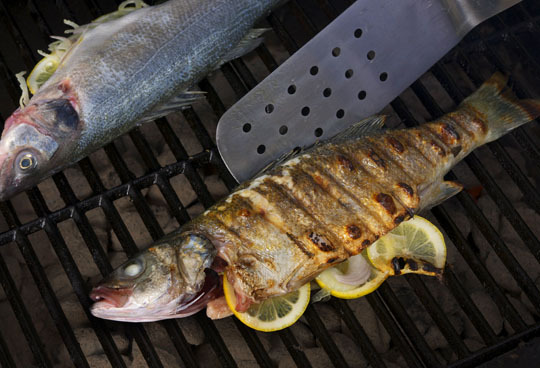
A perfectly grilled branzino. Photo by Donna Turner Ruhlman.
A confession: I’m not a great cooker of fish. In fact, Donna hates it when I cook fish, because I usually want to put some kind of fancy sauce on it. She wants it sautéed with plain lemon, a little butter maybe. (Yawn.) But she’s usually right—I don’t cook it often enough to get good at it. But another part of the reason I’m fish challenged is that I grew up in Cleveland in the 1970s where fish came into the grocery store on Monday (trucked in, no doubt) and sat around through Saturday, which was the only time in Cleveland you could get a good sense of what low tide smells like. The only fish I ate, and ate grudgingly, was breaded, fried, frozen, and reheated in a toaster oven, and I was able to get it down only with a stiff shot of tartar sauce.
Fish was never part of my life.
When I found myself working grill station in St. Andrew’s, I grilled salmon, and at the first pickup the chef made sure I served the gray, fatty side down the next time. Grill station at Sans Souci a couple years later, I grilled steaks, lamb chops, salmon, and halibut. Salmon is a decent fish to grill, but the halibut was a bitch because if you weren’t constantly throwing logs into the fire, which, frequently in the weeds, I would neglect to do, the fish would stick and really screw up my night. You can grill cod, and it’s very tasty, but it really wants to stick, too, and it gets so flaky that it’s really hard to grill without it falling apart and becoming a mess.
But: whole fish—whole, single-portion, skin-on, bone-in fish—are awesome on the grill, and very easy to cook. Most important, they give the fish-challenged cook, such as myself, a big window for doneness. Fish fillets have to be cooked on the money—they go from perfect to overcooked very quickly. Whole, skin-on fish have their bones to flavor the meat and keep it moist, and the skin protects the delicate flesh. This is what makes trout a great fish to grill.
Branzino (plural, branzini) may be the best. Why? Because of their bones. They’re high in cartilage, meaning that when the flesh gets hot, instead of overheating and drying out, it melts the cartilage so that the flesh stays succulent long after the fish has hit the right temperature. (The fish may be more universally known as European sea bass, but with all the different bass out there, I favor a distinctive name, so branzini it is. Ours were from Whole Foods, farm-raised to WF standards in Greece, and cost less than $9 each.)
The fish above sat around for many minutes (a maddening length of time to hungry me) while Donna made sure she got shots she liked. By the time we finally sat down to lunch (sautéed fennel and zucchini, kept warm in a sauté pan on the grill, grilled sourdough and cold white wine), the flesh had stayed amazingly juicy.
Donna, who usually simply says while eating such a meal, “Michael, just admit it, you can’t cook fish,” actually swooned. She could not believe it. Even the skin, charred and crispy, was delicious. “I told you you were going to like this,” I said. She shook her head and swooned some more. God, it makes me happy when she loves something so much.
The basics: have your fishmonger remove guts and gills, scale it, and snip off the pectoral fins (or do it yourself). Stuff the fish with flavorful aromatics. Build a super hot fire and make sure you let the grate itself get really hot. Rub your fish with oil, oil your grill, and press the fish gently down on the grate so it sears (don’t move it, let cook so that it doesn’t stick). I did these about 4 minutes a side, covering the grill for half the time to make sure the aromats heated through (they flavor the meat and their moisture also helps to keep the fish from overcooking).
So, in the end, the first lesson in how to grill fish is how to choose which fish to grill.
Grilled Branzini with Fennel, Lemon, and Shallot
4 branzini, scaled, gills and pectoral fins removed (they’ll be 10 to 12 inches/25 to 30 centimeters long and weigh a little under a pound apiece)
1 fennel bulb with fronds
Fine sea salt
1 shallot, thinly sliced
8 thin slices of lemon
Olive oil
Prepare a very hot fire with enough coals to grill all the fish over direct heat.
Remove the fronds from the fennel to use for stuffing the fish. Halve the fennel and cut four thin slices, also for stuffing the cavity. (Julienne the rest and sauté it as a side dish along with zucchini; shave it thinly on a mandoline and toss with lemon juice, shaved red onion, and olive oil; or reserve for another use). Lightly salt the fish cavities. Stuff 2 lemon slices, 2 fennel slices, the fennel fronds, and some shallot in each fish. (If you’re concerned about the garnish falling out when you turn the fish, feel free to secure it with two toothpicks.) Rub both sides with olive oil. Sprinkle both sides with salt.
Rub the grate of the grill with oil and lay the fish on the grill. Cook until the skin is browned, about 4 minutes. Turn the fish, careful not to let the stuffing fall out. Cover the grill and cook until the fish is warm in the center. (An instant-read thermometer inserted high into the cavity against the spine should read about 140°F/60°C. The fish, thanks to the bones, can rest for 5 minutes or so while you finish the side dishes, and will remain hot and moist.) Remove the stuffing before plating, and discard.
Serves 4
If you liked this post, take a look at these links:
My recent post Cooked Food for Thought (and Speech).
Check out my book Ruhlman’s Twenty.
Learn more about the branzino and what kind of fish it is.
Saveur gives a list of their top grilled fish recipes.
© 2013 Michael Ruhlman. Photo © 2013 Donna Turner Ruhlman. All rights reserved.
June 21, 2013
Friday Cocktail Hour: The Sea Breeze
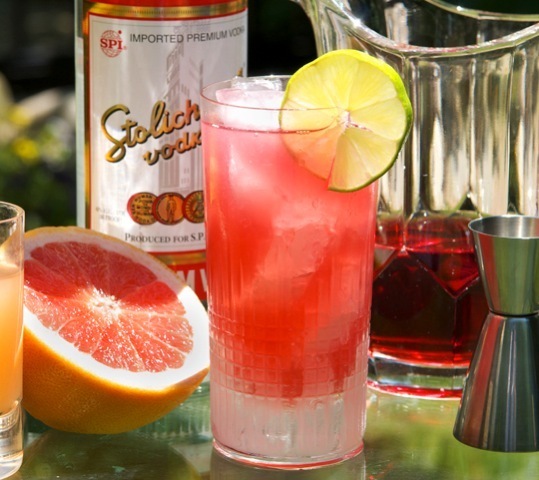
A hot summer eve calls for a cold Sea Breeze. Photo by Donna Turner Ruhlman.
The first table I ever waited on would comprise two serious chefs, Richard Czack and CIA prez Ferdinand Metz, and the parents of a seminal American chef. It was in the St. Andrew’s restaurant at the Culinary Institute of America and it is forever linked in my mind with two similar drinks, the Sea Breeze and the Madras. The following is from the book that forever altered my course:
Chef Czack did not look like a chef—balding, glasses, slight of frame; I didn’t know his age but he seemed elderly. His voice was nasal, fussy. He looked and sounded more like an accountant’s clerk. But Chef Czack was in fact a certified master chef and I was excited to be serving him and his guests, Mr. and Mrs. Forgione, parents of celebrity chef Larry, and an unnamed fourth. This would be fun.
Chef Czack and the Forgiones arrived as scheduled and were shown to table forty-two, at the back of the room, immediately in front of the dormant fireplace. Like a horse out of the starting gate, I broke for the table, greeted the three guests, and, standing at Mrs. Forgione’s right, asked if anyone cared for something to drink. Mrs. Forgione wanted something nonalcoholic and ordered a Sea Breeze [the restaurant served beer and wine only as I recall]. Mr. Forgione said that he had no idea what a Sea Breeze was. Chef Czack looked to me and said, ‘Tell us, what is in a Sea Breeze?’
Certainly, Chef Czack had asked for the benefit of Mr. Forgione. He had not asked because he himself was curious, I don’t think, or to test me in front of the guests, to show off the students, yet something in his tone led me to squint a little, as if to show I was working diligently at a tricky problem. I’d long known what a Sea Breeze was and we’d been tested on it as well, but I still made it look difficult. Then, with pride and confidence of having accomplished this difficult task, I said, ‘A Sea Breeze is three-quarters orange juice and one-quarter cranberry juice.’
Chef Czack, if my recollection is correct, said something in response. He could just as well have been speaking Chinese for all I understood. Something had gone wrong with my ears. I nodded and smiled. Chef Czack may have said, ‘Traditionally what you described resembles what we might call a Madras. A Sea Breeze is made with cranberry juice and grapefruit juice.’ I do know that he had not said, ‘Sorry, pal,’ and he had not made a Jeopardy wrong-answer noise. Either of those would have penetrated the fog that had rolled into my head. I had become so oblivious that I did not even realize the mistake until later, as I tried to reconstruct the events of the day—much as one might glue together a broken vase.
—From The Making of a Chef: Mastering Heat at the Culinary Institute of America
So began my days-long career as a waiter. I was astonished by how hard it was. It got easier of course, but it was there that I realized that servers got slammed just as hard as cooks, and cooks didn’t have to deal with people. People could really fuck your day up. People, whom yet another master chef described to me once, with wave of his hand, as “the sea of mediocrity out there.”
I was right at home in a kitchen.
To this day, a Sea Breeze reminds me of that day. It’s a lovely, refreshing drink, wonderful for summertime imbibing, and I especially like the bitter note the grapefruit juice gives it.
Happy Friday, all.
Sea Breeze
Traditional
1.5 ounces vodka
3 ounces cranberry juice
1 ounce grapefruit juice
slice of lime, for garnish
Combine all ingredients except the lime slice in a tall glass, then fill it with ice.
Squeeze in the lime and drop it in as garnish.
Ruhlman’s Sea Breeze
2 ounces vodka
2 ounces cranberry juice
1 ounce grapefruit juice
slice of lime garnish
Combine all ingredients except the lime slice in a tall glass, then fill it with ice.
Squeeze in the lime and drop it in as garnish.
If you liked this post, take a look at these links:
I write about how I got to the Culinary Institute of America and how I became a writer about food and chefs in the Kindle Single The Main Dish
My past cocktail posts with vodka: the Cosmo, Lemon Drop and the Moscow Mule.
9 essential tiki drinks.
Check out this article on the history of the Sea Breeze.
© 2013 Michael Ruhlman. Photo © 2013 Donna Turner Ruhlman. All rights reserved.
June 18, 2013
Cooked Food for Thought (and Speech)
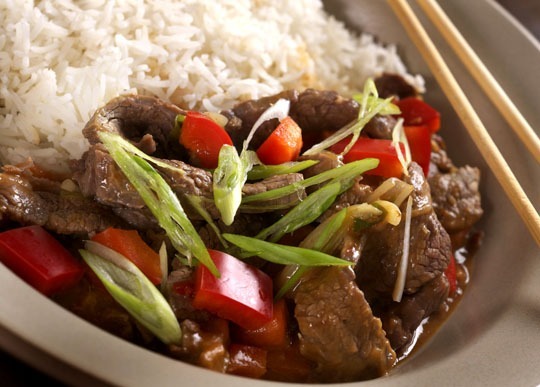
A fast dinner, beef stir-fry. Photo by Donna Turner Ruhlman.
It made so much sense the second I read it. One of those “of course!” moments. It was, not atypically, while reading Michael Pollan in his NYTimes magazine story a few years ago about how no one cooks anymore (really?). Certainly in the 1980s and 1990s most of the country relied on reheating already-cooked food for their meals. And perhaps as a result, at least in part, we became a grossly obese country where seemingly the only people who dieted were the people who were already thin, and the rest made increasingly bizarre, unsustainable stabs at it. A physically sick country, a confused country—don’t get me started.
The “of course” moment. It didn’t come from Pollan, but rather from a researcher he interviewed, Harry Balzer, who works for the market research behemoth NPD, and studies all kinds of eating trends.
Pollan writes: “So I asked him how, in an ideal world, Americans might begin to undo the damage that the modern diet of industrially prepared food has done to our health?”
“Easy [Balzer said]. You want Americans to eat less? I have the diet for you. It’s short, and it’s simple. Here’s my diet plan: Cook it yourself. That’s it. Eat anything you want—just as long as you’re willing to cook it yourself.”
Since I read that chillingly simple idea, I’ve adopted it as a mantra. Pollan took the idea and ran book-length with it in Cooked, published this spring. Combine food you cook yourself (or a meal that was cooked by your partner, parent, progeny, or pal) with common sense and you’re on the way to a good life.
In his article, Pollan mentions the work of Richard Wrangham and his superb book Catching Fire: How Cooking Made Us Human, published a half year earlier. This is another major argument in the case for the fundamental importance of food to our humanity (something that once would have seemed so obvious as to not need arguing). One of his claims is that because cooking took work, a lot of work, but came with advantages too self-evident to ignore, we had to cooperate in order to take advantage of the miraculous benefits cooked food gave to animals. I hyperventilate about Wrangham’s main premises here.
Several weeks ago, eating leftovers for lunch at my desk while watching a TED talk, which is my preferred lunchtime diversion, I chanced on Mark Pagel’s soliloquy on “the most powerful, dangerous, and subversive trait that natural selection has ever devised,” a bit of interior technology we all possess that’s capable of, he said, “rewiring other people’s minds.” Language. Our ability to plant an idea in another’s mind, and vice versa. Without it, cooperation is all but impossible. He contrasts a pre-verbal negotiation with a verbal one. Much more efficient when two parties speak the same language. (He notes that we tend not to have sex with people if we can’t speak with them—that’s been my experience too. Language required.)
Pagel’s talk made me wonder: Did cooking food, which necessitated cooperation, have anything to do with the development of language and with it the rapid growth of our species across the globe?
I wrote to Wrangham to ask if he knew of any studies correlating the development of language with cooked food. He didn’t. He speculated that there may be important links but no one he knew of had written about it. He noted that we were “speaking” of spoken language, not signed, aural language and our unique capacity to create extraordinarily nuanced sounds. And this means anything from a … skeptically … uttered phrase in everyday conversation, to the artistry of Leontyne Price or Cyndi Lauper.
He explained: “Another area that would seem worth exploring … is the relationship between the velum and the larynx, which everyone seems to agree is fundamental to the production of a rich set of sounds. I am tempted to think that an important consequence of cooked food could be the reduced amounts of food that need to be swallowed, with consequences for reduced size of the oesophagus and the potential for a more elaborate vocal anatomy.”
Our vocal structures may have been able to develop because we didn’t have to send half our body weight through our throat every day in the form of chewed-up plants. He reiterated that this was idle speculation. I think it’s worth exploring. There is rarely a single explanation to a complex circumstance, but rather an infinitely nuanced self-spinning weave that reveals how we got where we are. Was it cooked food alone that enabled the language that necessitated cooperation? Idle speculation would lead us to believe that the answer is no. One helped the other over many, many generations, and many intermingling of tribes.
Pagel ended with the idea that we might be headed toward one world, with one language, thereby freeing up the delay of the spread of ideas and cooperation.
One thing I have learned is that there is one language everyone already understands, is eager to share, and is eager to accept, and it’s not surprising. A good, shared meal. The best language I know.
If you liked this post, check out these other links:
Wrangham also directed me to the work of Michael Wilson, an anthropologist at the University of Minnesota who studies primates for what we can learn about human evolution. He has an excellent site of his own called Monkey Business.
Civil Eats is a great resource to learn more about food policy and politics.
Support local farmers by finding the ones near you at Local Harvest.
© 2013 Michael Ruhlman. Photo © 2013 Donna Turner-Ruhlman. All rights reserved.
June 14, 2013
Friday Cocktail Hour: The Cosmopolitan

The Cosmopolitan. Photo by Donna Turner Ruhlman
What else with the fried chicken for a graduation lunch? Any special beverages for graduation? “Kathy likes Cosmos,” our soon-to-graduate daughter offered. We considered. But this was lunch, so we decided to keep it to wine and beer, and a champagne toast for the three graduates we were to celebrate (gosh, they are so much more responsible than I was, praise the Lord). But that Cosmo idea. It stuck. Because Kathy Mustee, wife and mom of four including newly graduated twins, is a pleasure to be with, smart, and, significantly, she is not to be trifled with. Even my daughter fears the Wrath of Kathy, the only person I know her openly to fear (I’d have paid Kathy for lessons had I known). And she likes Cosmos.
Clearly, the Cosmopolitan, a pink vodka-based drink needed to be reconsidered. The Wiki description is fascinating for its history. This is a young cocktail, I knew, but I had no idea how colorful a cocktail of only a generation could be. So I mixed one, determined to make it today’s Hour, and I’ll be damned if it’s not a superlative cocktail, vodka and all. I’m offering two versions, the standard (minus the citron vodka, see history, add lemon if you want lemon), followed by what I prefer. Everything to taste as always.
I can’t help thinking though, Wrath of Kathy notwithstanding, that gin would be better. Isn’t it always?
But that’s for another Hour. Till then, cheers, congrats, and thanks to our friends Kathy and Kevin (and Barb and Clem!).
Good summer to all!
The Cosmopolitan
This is traditional and would have been what Carrie Bradshaw was served until she stopped drinking them because everyone else started.
1.5 ounces vodka
1 ounce cranberry juice
0.5 ounce triple sec
0.5 ounce lime juice
Lime slice garnish
Combine all ingredients except the lime slice in a container, fill it with ice, stir till everything is nice and cold and the ice has tempered the hooch.
Strain into a chilled martini glass.
Garnish with lime slice.
Ruhlman’s Cosmo For Real Men
(and fake men) (and women who are girlie men down deep)
This is my preference for strength, size, and especially the balance between the sweetness of the triple sec component—here, Cointreau—and the acidity of the lime.
60 grams vodka (2 ounces)
45 grams cranberry juice (1.5 ounces)
25 grams Cointreau (a little less than 1 ounce—0.892857 to be [almost] exact)
20 grams lime juice (0.75 ounce)
Lime slice garnish
Combine all ingredients except the lime slice in a container, fill it with ice, stir till everything is nice and cold and the ice has tempered the hooch.
Strain into a chilled martini glass.
Garnish with lime slice.
If you liked this post, take a look at these links:
My past cocktail posts with vodka: the Lemon Drop and the Moscow Mule.
DIY triple sec: Is it better to make it yourself or to purchase it?
How about making a Barbados Cosmo? Just swap out the vodka with golden rum.
An interesting read, the history of sweet cocktails.
© 2013 Michael Ruhlman. Photo © 2013 Donna Turner Ruhlman. All rights reserved.
June 12, 2013
Graduation Fried Chicken

Perfectly cooked fried chicken! Photo by Donna Turner Ruhlman.
For her high school graduation lunch last week, my daughter asked for my fried chicken. Normally, I break down a chicken into 9 pieces and cook it and serve it. But we’d invited friends, bringing our total number to 20. Fried chicken for 20 is different from fried chicken for four. I had no intention of spending all that time frying while hosting the lunch.
But it wasn’t until we were seated and one of the guests, while biting into a juicy drumstick, asked, “You can do this ahead of time?” did I realize that I must, must post on this subject, to deepen our understanding and encourage more cooking of one of the greatest dishes in the American repertoire.
Yes, this can be done the day ahead. Follow all the steps below, though you don’t need to cook everything all the way through, just get the pieces beautifully browned, let them cool, then refrigerate them, preferably on a rack (space can be an issue so isolate fridge territory before you begin). On the day of the meal, pop them into a 300°F/149°C oven for 30 to 40 minutes (or longer, though be careful not to overcook the breasts—use your common sense on that one, as the breasts need only about 20 minutes total to reheat).
Use convection if you have it. The juices can begin to drip down and make the bottom soggy, so if you think about it, give the pieces a turn midway through cooking.
Fried chicken is a great do-ahead meal.
What follows is a previous post on the basics of fried chicken, a dish more people should do at home. This is for THE BEST fried chicken. (If you’re pressed for time, simply rolling the chicken in heavily peppered flour and slipping the pieces into hot fat is perfectly acceptable. [What a felicitous pairing of words: Hot fat. Hot fat. Never noticed how pleasing those words are when set next to each other.])
How to Fry Chicken
Originally posted: February 9, 2012
Fried chicken, done right, is one of the best things to eat on earth. It’s all about the proportions—crunchiness: juiciness: chewiness: savoriness. And this ratio hits golden proportions with the wing, lots of crunchy peppery surface area and sweet succulent meat.
The study of fried chicken began for me in 2007 during discussions, observations, and eating with chef Dave Cruz at Ad Hoc in Yountville, CA, as we worked on the book Ad Hoc at Home. While Ad Hoc’s method of flour-buttermilk-flour is not unique, their trial and error experimentation with various methods (including sous vide) proved to them and to me that this method is indeed superlative.
That was 2007, and I’ve since fried a lot of chicken. My recipe is in Ruhlman’s Twenty. I think it’s better than the one in Ad Hoc (I do a rosemary-lemon brine and season my flour differently). But talk to another chef, such as Michael Symon, and he’ll say his is better. If you want a great starting point, the exact Ad Hoc recipe is at the Amazon book link for Ad Hoc at Home above; it’s excellent. Here I’ll address the key points of great fried chicken, with a nifty slide show of pix by my wife Donna. (And I should pause briefly to thank her; as you can see, the gorgeous process shots, which fill Ruhlman’s Twenty, are really what make the book both a great teaching tool and a powerful object. Thank you, DT, for your great work!)
A couple of things to make clear at the outset, especially to those wary of deep-frying. Use a big high pot, fill it no more than one-third full, and you shouldn’t have any worries about fire (if you ever do have one, don’t freak out, simply put a lid on it; those around you who are freaking out will marvel at your calm control).
About fat, yes there’s more fat in fried chicken than in baked skinless breast, but not all that much. Deep-frying gets a bad rap. Eat a balanced diet, which, as far as I’m concerned, includes fried chicken once every few months for its spiritual and mental health benefits in addition to being fun to eat.
Key Steps to Otherworldy Fried Chicken
Brine it. I use a 5% brine overnight and I’m partial to rosemary as the dominant herb flavor. Brine seasons and flavors the meat and also keeps it juicy.
If you have time, let the chicken sit out of the brine to let the skin dehydrate further.
Make a flavorful flour mixture. I think an aggressive use of ground black pepper is the critical factor (I use about a tablespoon per cup). I also use a lot of paprika and cayenne.
Buttermilk: it’s all about the viscosity, not the buttermilk. If you don’t have buttermilk, thin yogurt or sour cream with milk. I don’t season the buttermilk, it’s a waste of the seasoning. All your seasoning should be in your flour.
Flour, buttermilk, flour, and into the oil. The first flour is to give the chicken a dry surface that the wet buttermilk will stick to. Flour in a separate bowl then sticks to the buttermilk.
I bring the oil to 375°F/190°C because the heat drops so fast when you put all the chicken in.
Remove to drain on a rack; don’t let it sit on a tray in its own oil.
For legs, thighs, and wings, I like to finish them in a 250°F/120°C oven to make sure they’re super tender and to further crisp them. This lets me serve it whenever I want, no last-minute frying if guests are invited. I brought the above wings to Mac’s house and reheated to crisp them up during the first quarter of the Super Bowl while we watched lame commercials.
Finishing garnish: it’s always nice. I deep-fried some rosemary and zested lemon over the chicken.
If you liked this post on how to fry chicken, check out these other links:
My post on pickled green tomatoes.
Stephanie Stiavetti’s guest post on gluten-free fried chicken.
Here are a few of the top fried chicken restaurants in the States: Pie-n-Thighs, Two Sisters Kitchen, and Son of a Gun.
Next time you are in Corbin, Kentucky, visit the Colonel Harland Sanders Museum.
© 2012 Michael Ruhlman. Photo © 2012 Donna Turner-Ruhlman. All rights reserved
Michael Ruhlman's Blog
- Michael Ruhlman's profile
- 354 followers




